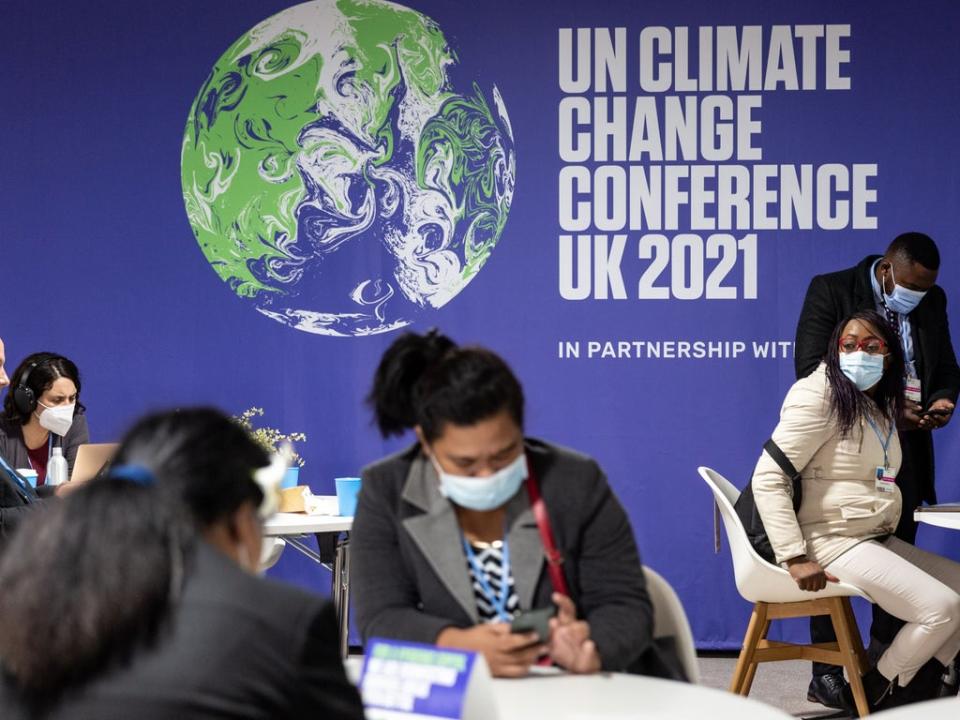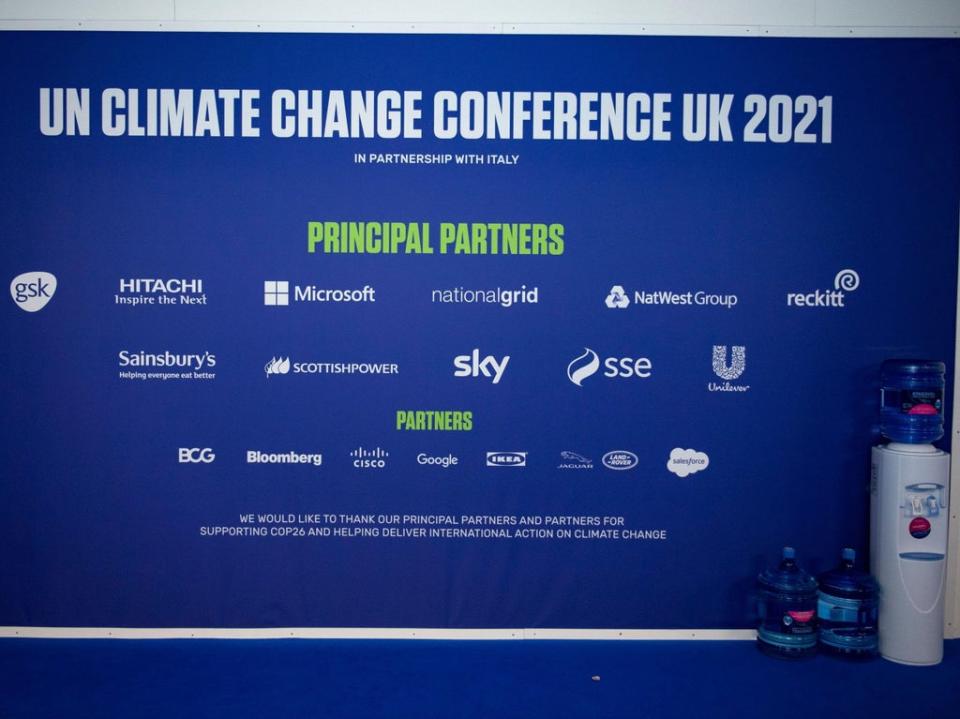Cop26: How green are climate summit’s key sponsors?

The sponsors of the Cop26 climate summit have made bold pledges to get to net zero, but an investigation by The Independent has uncovered a substantial – and often hidden – reliance on controversial carbon offsets to get there, which environmentalists have branded “a license to keep polluting” and “a greenwashing scam”.
These 11 firms – Microsoft, Unilever, Sky, SSE, Scottish Power, Sainsbury’s, Reckitt, National Grid, Hitachi, GSK, and NatWest Group – have had their logos plastered all over the website of the biggest climate change event of the year, and inside its Glasgow venue, with each company hyped as a leader in their sector trailblazing the way “towards net zero”.
Last year they generated £260bn in revenue, but collectively pumped out more than 375m tonnes of carbon.
Most have committed to reducing their carbon output to net zero by 2050, and in many cases much sooner, but when you dig below the surface, there is a very significant reliance on carbon offsetting that environmentalists say “hugely undermines their credibility as climate change leaders”.
Carbon offsets refer to the reduction in greenhouse gas emissions or increase in carbon sequestration – such as by planting trees – used to compensate for a company’s own emissions. Typically they involve companies in the global north continuing to pollute but seeking to abate their emissions in their net zero commitments by investing in afforestation or, even more controversially, the apparent avoidance of deforestation, in the global south. We found that:
Sky is 50 per cent reliant on offsets to get to net zero, Scottish Power 37 per cent and Microsoft 36 per cent;
Sainsbury’s plans to meet its 2030 target of cutting scope 3 emissions – indirect emissions upstream or downstream of its own operations – by 30 per cent without offsets, but this leaves it almost 70 per cent short of net zero and would, the supermarket admits, require use of offsets or new technology to go further;
Five Cop26 sponsors refused to put a number on their expected use of offsets, claiming that this data was “commercially sensitive” or that that they will be used for “residuals only” – while declining to specify how much residuals are expected to comprise;
Only National Grid said it plans to meet its commitments without resorting to offsets in any shape or form.
Responding to our findings, Greenpeace said: “This is incredibly disappointing and doesn’t sound like climate leadership. We are seeing companies make shiny pledges to get to net zero but not backing it up with credible action and over-relying on somebody else to sort out the problem. Offsets are a cynical and dangerous form of greenwashing that will harm our ability to do the innovation needed to limit the global temperature rise to 1.5C – the goal of the Paris agreement. In short, offsets are a get-out clause and a scam.”
Environmentalists say the problem with offsets is that they avoid investment in the much-needed transformation that will reduce a company’s emissions. Greenpeace added: “In some cases they involve paying people not to cut down trees, but it is very hard to prove additionality – that this wouldn’t have happened anyway – because a lot of action or legislation to curb deforestation is already in place from local governments. It’s also an opaque, non-transparent market in which calculations of how much you are reducing emissions are simply estimates and like staring into a crystal ball.”
There is still no legal requirement in the UK for companies to publish their reliance on offsets in meeting their eye-catching goals, and many Cop26 sponsors fail to do so. It means that transparency over offsets is still a choice, despite widespread concerns over the quality of offsetting schemes in a system that is voluntary and unregulated.
Some Cop26 sponsors have sought to be more discerning about the offsets they use, saying they would avoid certain types. For instance, Microsoft said it had changed their policy and would no longer invest in offsets that “pay someone not to cut down trees on the land they own (carbon avoidance)” and instead buy only offsets that lead to “planting more trees and actual carbon removal”. Sky said it would invest in offsets, “but only credible” ones, adding: “There are currently not enough credible carbon offsets out there.”

Similarly, consumer goods conglomerate Unilever said it would “not purchase avoided emissions credits to meet carbon reduction targets” and that avoided emissions and carbon removals should be identified separately within the carbon contract nomenclature. NatWest said it would use offsets but understood “carbon offsetting is only an interim solution”.
Some Cop26 sponsors argued that because scope 3 emissions – which amount to over 90 per cent of their total emissions – are out of their direct control, they need offsets to reach net zero. But Greenpeace said: “That is not taking responsibility for the huge power these corporations exert over their upstream and downstream chain. They have used their influence to change behaviour when it comes to human rights abuses in factories that supply them, so why not when it comes to climate change.”
Environmentalists also question whether there is enough land globally to accommodate all the planned offsets. A report by Oxfam this year showed that using land alone to remove the world’s carbon emissions to achieve net zero by 2050 would require new forests equivalent to five times the size of India, or more than all the farmland on the planet. Oxfam added that too many corporations were “hiding behind unreliable, unproven and unrealistic ‘carbon removal’ schemes in order to claim their 2050 climate change plans will be net zero”.
The recent wildfires also put a dent in the credibility of offsets, with Microsoft acknowledging that wildfires raging in north America had resulted in a significant portion of their offsets going up in smoke, releasing carbon into the atmosphere instead of abating it. “We’ve bought forest offsets that are now burning,” admitted Elizabeth Willmott, its carbon programme manager, at a climate change conference earlier this year.
But is there a level of offsetting that is acceptable and commensurate with staying below the 1.5C rise on pre-industrial temperatures, the goal of the Paris Agreement? “It varies by economic sector,” said Greenpeace. “A few sectors – such as steel, chemicals and cement – legitimately need a small degree of offsetting to get to zero, but in most sectors the technology is already there and there is no case for relying on offsets, even for residual emissions.”
How Cop26 sponsors rely on offsetting to hit net zero
SAINSBURY’S: 68 per cent reliant on offsets
Emissions: 27.8m tonnes of CO2e
Commitment: Invest £1bn over 20 years to become net zero across scopes 1-2 by 2040, and cut scope 3 by 30 per cent by 2030.
Offsets reliance: Cuts of 8.9m tonnes planned “without prioritising offsetting”, but to go further and get scope 3 to net zero by 2030 would, they said, “require new technology or carbon offsets” – amounting to 18.9m tonnes.
SKY: 50 per cent reliant on offsets
Emissions: 2.34m tonnes
Commitment: Net zero by 2030
Offsets: “Our target to be net zero will be met by an absolute reduction in emissions of 50 per cent and by offsetting the remaining 50 per cent of our emissions – amounting to 1.17m tonnes – through natural carbon sinks and technology. We won’t get to net zero by reducing emissions alone.”
SCOTTISH POWER: 37 per cent reliant on offsets
Emissions: 9.57m tonnes
Commitment: Invest £10bn in clean energy over five years to cut scopes 1-3 by 63 per cent by 2030 via permanent carbon removals and without offsets, but also – as part of the Iberdrola Group – “to be carbon neutral by 2030”.
Offsets: There is a stark mismatch between the Scottish Power target that gets them 63 per cent to net zero by 2030 and the pledge imposed by their holding company Iberdrola Group to be 100 per cent net zero by 2030 – with the implication that 37 per cent of offsets amounting to 3.5m tonnes will be needed to achieve the group goal.
MICROSOFT: 36 per cent reliant on offsets
Emissions: 15.6m tonnes
Commitment: Carbon negative across scopes 1-3 by 2030.
Offsets: Microsoft say 5.7m tonnes of carbon offsets – 50 per cent of scope 3 – will be needed to meet its 2030 goal.
GSK: 20 per cent reliant on offsets
Emissions: 15.9m tonnes
Commitment: GSK will split into two companies in 2022. Its pledge for its biopharma business (70 per cent of emissions) is to be net zero across scopes 1-3 by 2030, and for its consumer healthcare business (30 per cent of emissions) to be net zero across scopes 1-2 and across scope 3, for select (unspecified) brands only.
Offsets: “We aim to use carbon removals [offsets] for 20 per cent of our biopharma footprint” – which amounts to 2.22m tonnes. (Use of offsets for the consumer healthcare business has yet to be announced.)
NATIONAL GRID: 0 per cent reliant on offsets
Emissions: 35.9m tonnes
Commitment: Net zero across scopes 1- 3 by 2050.
Offsets: “We aim to be net zero exclusive of offsets across scopes 1, 2 and 3 by 2050.”
NATWEST GROUP: Unspecified reliance
Emissions: 8.4m tonnes excluding most scope 3 financed emissions (associated with their lending and investment activity) which the bank has “yet to calculate”
Commitment: Cut scopes 1-3 by 50 per cent by 2030 and net zero across scopes 1-3 by 2050.
Offsets: Currently 132,000 tonnes of offsets are used and at least 120,000 tonnes will be maintained through to 2025. But this excludes the very big number that will likely be required to reduce total financed scope 3 emissions.
HITACHI: Unspecified reliance
Emissions: 110.53m tonnes
Commitment: Cut scopes 1-3 by 50 per cent by 2030, and by 80 per cent by 2050.
Offsets: “Offsetting will be needed for emissions that cannot be minimised via renewables, energy efficiency or other means, but the exact figures are commercially sensitive.”
UNILEVER: Unspecified reliance
Emissions: 98m tonnes
Commitment: Net zero by 2039 across scopes 1- 2 and across some scope 3 amounting to 32m tonnes, but this pledge excludes indirect scope 3 emissions of 66m tonnes, which relate to their customer use of products.
Offsets: To achieve its net zero pledge relating to 32m tonnes, “the priority is to remove emissions in absolute terms and offsets will be used for residuals only”, though what comprises “residuals” is “too early to say”. Regarding the remaining 66m tonnes, it is also “too early to say” how much offsets would be used as these emissions are “outside our direct control” but “carbon markets have an important role to play”.
RECKITT: Offsets reliance under consideration
Emissions: 39.6m tonnes
Commitment: Net zero across scopes 1- 3 by 2040.
Offsets: “We are considering the need for offsets to achieve our ambition for 2040, but our aim is to reduce our emissions as far as possible in advance of that.”
SSE: Unspecified reliance
Emissions: 11m tonnes
Commitment: Net zero across scopes 1-3 by 2050.
Offsets: “Offsetting does not play any part of SSE’s plans”, the firm said, however offsets would be needed to “neutralise residual emissions”, which are not specified.
Note: Emissions comprise scope 1 and 2 (emissions from a company’s own operations) and scope 3 (emissions upstream and downstream of the company’s operations)
Read More
Cop26 news: Prince Charles calls summit ‘last chance saloon’

 Yahoo News
Yahoo News 